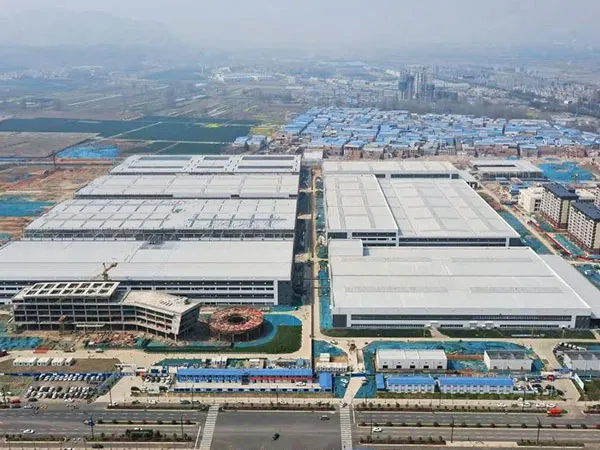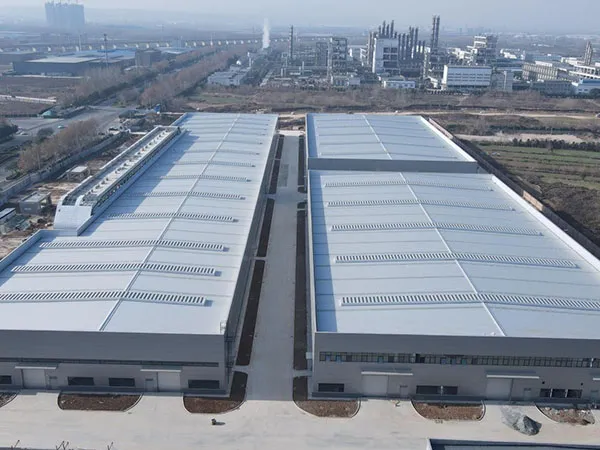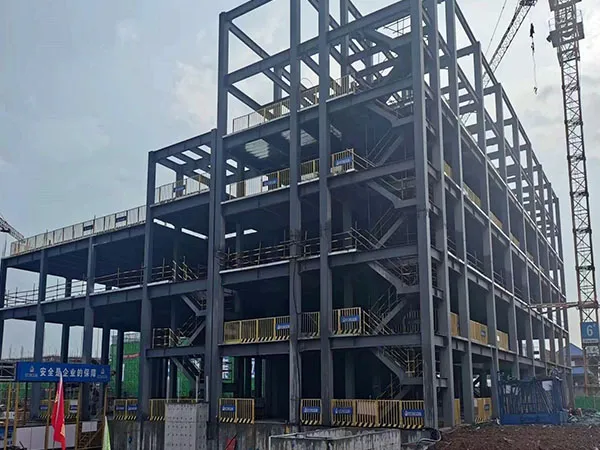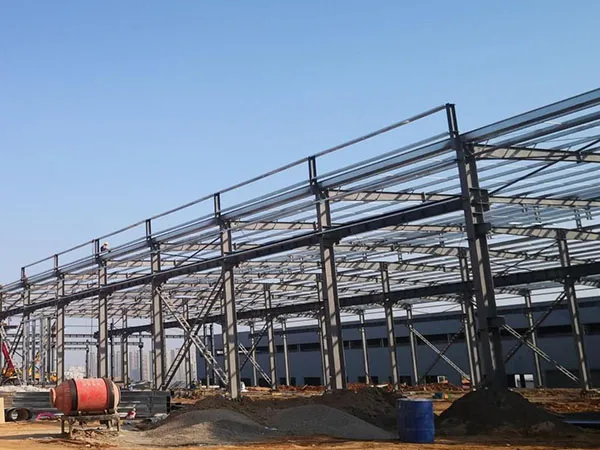Time:2025-03-14 06:12:07 Source:Sanjian Meichen Steel Structure
Steel structures dominate the industrial building and infrastructure sectors, owing to their exceptional strength and versatility. However, steel's inherent properties also make it susceptible to corrosion. Without effective protection, their structural integrity and service life are significantly compromised. Therefore, professional anti-corrosion painting is crucial for extending the lifecycle of industrial steel structures.
This isn't just for aesthetic reasons; it's a crucial engineering measure designed to protect against harsh industrial environments, chemical attack, UV radiation, and moisture. This article will comprehensively and in-depth explore all aspects of industrial steel painting, from preliminary preparation and coating selection to application techniques, quality control, and ongoing maintenance, revealing how to ensure optimal protection and maximize the lifespan of your steel structures.
The industrial steel structure painting process is a multi-step process designed to protect the steel from corrosion and enhance its aesthetic appeal. A well-executed industrial steel painting process enhances durability, prevents rust, and maintains structural integrity. Following standard protocols ensures a long-lasting protective coating.
Any successful painting project begins with thorough surface preparation. This stage directly impacts coating adhesion, durability, and overall corrosion protection, and should never be neglected.
1.1 Surface Cleaning:
Removal of Dirt and Contaminants: The surface must be thoroughly cleaned of all loose rust, mill scale, old paint film, oil, grease, dust, salt, and other impurities. These contaminants can hinder the effective bonding of the paint film to the substrate.
Cleaning Methods: Common cleaning methods include solvent cleaning (to remove oil), high-pressure water washing (to remove salt and loose contaminants), and mechanical cleaning.
1.2 Rust Removal:
Sandblasting/Shot Peeling (Grade Sa): This is the most effective and commonly used rust removal method. It uses high-velocity abrasives to remove rust and mill scale while creating a roughness (anchor texture) on the steel surface, significantly enhancing paint adhesion. Based on cleanliness, coatings can be classified into Sa1, Sa2, Sa2.5, and Sa3 grades, with Sa2.5 (near-white) being the standard typically required for industrial protective coatings.
Power Tool Rust Removal (St Grade): Use electric or pneumatic tools (such as angle grinders and wire brushes) to remove loose rust and old paint. Suitable for local repairs or areas where sandblasting is unavailable.
Manual Rust Removal: Use tools such as scrapers and wire brushes. Suitable for small or confined areas.
1.3 Surface Roughness (Anchor Mark) Testing:
Appropriate surface roughness ensures coating adhesion. This can be tested using a surface roughness meter or comparison specimens.
The coating system for industrial steel structures is not one-size-fits-all and must be carefully selected based on the specific environment, expected service life, budget, and aesthetic requirements. A complete anti-corrosion coating system typically includes a primer, midcoat, and topcoat. 2.1 Primer: The First Line of
Defense Against Corrosion
Purpose: Directly contacts the steel surface, providing excellent adhesion and initial corrosion protection.
Common Types: Epoxy zinc-rich primer (provides cathodic protection and excellent rust prevention), epoxy zinc phosphate primer, inorganic zinc silicate primer, etc.
2.2 Intermediate: Enhanced Protection and Thickness
Purpose: Applied over the primer, it increases the coating thickness, further enhances corrosion protection, and provides a smooth base for the topcoat.
Common Types: Epoxy micaceous iron intermediate (enhanced barrier properties and abrasion resistance), high-solids epoxy paint.
2.3 Topcoat: Aesthetics, Weatherability, and Additional Protection
Purpose: Exposed on the outermost surface, it provides color and gloss, and resists UV rays, chemical corrosion, abrasion, and weathering.
Common Types: Polyurethane topcoat (weather-resistant, excellent gloss and color retention), fluorocarbon topcoat (extremely long-lasting weatherability, self-cleaning properties), acrylic polyurethane topcoat, etc.
2.4 Special Function Coatings:
High-Temperature-Resistant Paint: For use on steel structures exposed to high temperatures.
Fire-Retardant Coating: Provides flame retardant or expansion protection during fires, extending the fire resistance of steel structures.
Chemical-Resistant Paint: For use in environments exposed to corrosive chemicals.

Proper application techniques are crucial to ensuring coating performance. Professional painting processes adhere to strict procedures and technical standards.
1)Environmental Condition Control:
Temperature and Humidity: Avoid low temperatures (below 5°C), high temperatures (above 35°C), or high relative humidity (above 85%) during application. The steel surface temperature should be at least 3°C above the dew point to prevent condensation.
Wind Speed: Avoid application in windy conditions to prevent paint mist and contaminant deposition.
2)Spraying Methods:
Air Spray: Suitable for a variety of coatings and flexible, but produces high mist.
Airless Spray: Highly efficient, produces uniform film thickness, and minimizes mist, making it the preferred method for painting industrial steel structures.
Brush/Roller: Suitable for small repairs or confined areas, but less efficient.
3)Coating Thickness Control: The wet and dry film thicknesses of each coat must be strictly controlled in accordance with the product specifications and design requirements. Use a wet film thickness gauge and a dry film thickness gauge for testing.
4)Intercoat Interval:
After each coat is applied, allow it to dry to the touch or until the recoating interval has expired before applying the next coat. Ensure intercoat adhesion.
5)Treatment of Edges, Welds, and Complex Areas:
These areas are vulnerable to corrosion and require additional pre-coating or thickening treatment (such as stripe painting).

Primer Application: The primer is the first coat applied and is crucial for corrosion protection and adhesion of subsequent coats.
1)Primer Types:
Zinc-Rich Primers: Provide excellent cathodic protection, often used in highly corrosive environments. Can be inorganic (e.g., silicate-based) or organic (e.g., epoxy-based).
Epoxy Primers: Excellent adhesion, chemical resistance, and durability. Widely used for structural steel.
Urethane Primers: Good flexibility and abrasion resistance.
Acrylic Primers: Fast-drying and good adhesion, often used as a base for acrylic topcoats.
2)Application Methods:
Airless Spraying: The most common method for applying industrial coatings. Provides good coverage and a uniform film thickness.
Air-Assisted Airless Spraying: Combines airless and air spraying for better atomization and reduced overspray.
Conventional Air Spraying: Older method, but still used for some applications. Can be less efficient and create more overspray.
Brush or Roller Application: Used for small areas, touch-ups, or where spraying is not feasible.
Intermediate Coat (Optional): Sometimes an intermediate coat is applied between the primer and topcoat. This coat can provide additional corrosion protection, build film thickness, or improve the appearance of the topcoat.
Topcoat Application: The topcoat provides the final layer of protection and the desired aesthetic properties (color, gloss).
3)Topcoat Types:
Epoxy Topcoats: Excellent chemical resistance, hardness, and durability. However, they can chalk and fade in sunlight.
Polyurethane Topcoats: Excellent UV resistance, gloss retention, and abrasion resistance. Often used as a topcoat over epoxy primers.
Acrylic Topcoats: Good UV resistance, color retention, and fast-drying. Often used for architectural coatings.
Alkyd Topcoats: Relatively inexpensive, but less durable than epoxy or polyurethane.
Application Methods: Same as for primers (airless spraying, air-assisted airless spraying, conventional air spraying, brush, or roller).

Strict quality control throughout the painting process is crucial to ensuring the ultimate protective effect.
1)Surface Preparation Quality Inspection:
Visual Inspection: Inspect surface cleanliness against standard photographs (e.g., ISO 8501-1).
2)Salt Test: Detect residual salt on the surface.
Roughness Test: Measure the depth of anchor marks on the surface.
Wet/Dry Film Thickness Inspection:
Measure the dry film thickness of each coat and the total coat using specialized equipment (e.g., eddy current or magnetic thickness gauges).
3)Adhesion Test:
Cross-cut Method: Use a knife to create a grid on the paint film. Apply tape and remove it. Observe the film as it peels off to assess adhesion.
Pull-off Method: Use a pull-off tester to measure the force required to peel the paint film from the substrate.
4)Visual Defect Inspection:
Inspect the paint film for defects such as sagging, orange peel, blistering, cracks, and pinholes. 4.5 Paint Film Integrity Testing:
Spark detector: Used to detect pinholes and cracks in thick film coatings to ensure the continuity of the paint film.

Allow the applied coatings to cure according to the manufacturer's recommendations. Curing times vary depending on the type of coating, temperature, and humidity.
For some coatings, forced curing (using heat) may be required to achieve the desired properties.
Industrial painting involves flammable and hazardous substances, and strict compliance with safety production standards and environmental regulations is required.
5.1 Personal Protection:
Workers must wear personal protective equipment such as protective masks, gloves, protective clothing, and safety glasses.
Ensure good ventilation in the work area and install exhaust ventilation.
5.2 Fire Prevention:
Painting materials are often flammable. Open flames are strictly prohibited on the construction site, and fire extinguishers must be available.
Paint should be stored away from sources of ignition and stored in designated locations.
5.3 Waste Disposal:
Waste paint, solvents, and paint-containing waste should be collected, stored, and disposed of in accordance with hazardous waste regulations. Unauthorized dumping is strictly prohibited.
Select low-VOC (volatile organic compound) paint to reduce environmental pollution.
VI. Maintenance and Repair of Steel Structures After Painting
Even high-quality paint systems require regular inspection and maintenance to ensure long-term protection. Regular Inspection: Conduct a visual inspection of the steel structure surface annually or every two years, paying particular attention to vulnerable areas (such as welds, edges, and bolted joints) and areas of increased corrosion risk.
Prompt Repair: Immediately clean and repair any paint damage, blisters, or rust spots to prevent the spread of corrosion. When repairing, use the same surface preparation and coating as the original system.
Cleaning: Regularly remove dust and dirt from the steel structure surface to prevent accumulation that may damage the paint film.
Key Considerations and Best Practices:
Manufacturer's Specifications: Always follow the coating manufacturer's instructions for surface preparation, mixing, application, and curing.
Safety: Use appropriate personal protective equipment (PPE) such as respirators, gloves, eye protection, and hearing protection.
Environmental Regulations: Comply with all applicable environmental regulations regarding air emissions, waste disposal, and VOC (volatile organic compound) content.
Competent Personnel: Ensure that all personnel involved in the painting process are properly trained and qualified.
Application Equipment: Use well-maintained and calibrated application equipment.
Contamination Control: Prevent contamination of the coating materials and the prepared steel surface.
Weather Conditions: Avoid painting in adverse weather conditions such as rain, high humidity, or extreme temperatures.
Accessibility: Ensure proper access for surface preparation, painting, and inspection.
In summary, the industrial steel structure painting process is a comprehensive procedure that requires careful planning, execution, and quality control to ensure the long-term protection and performance of the steel structure. The specific steps and materials used will depend on the environment, the intended use of the structure, and the project requirements. Consulting with a qualified coatings specialist is recommended to select the appropriate coating system and application procedures.